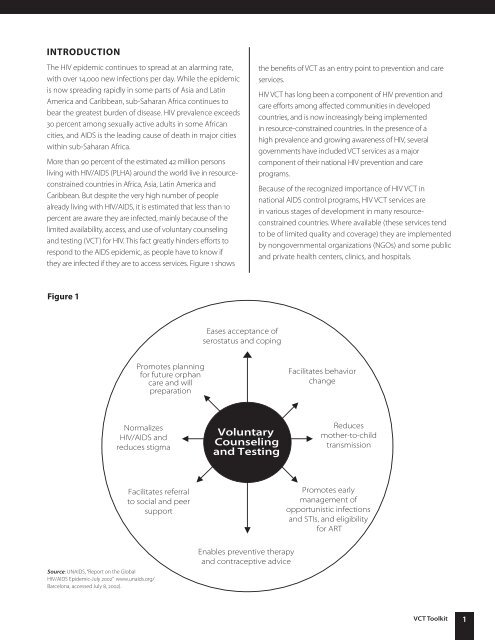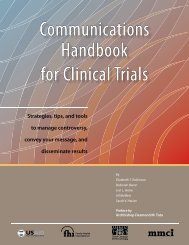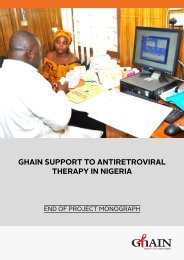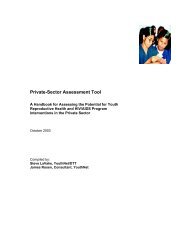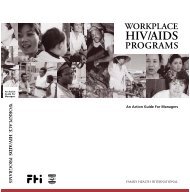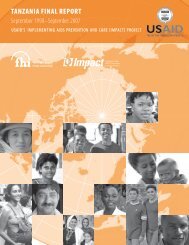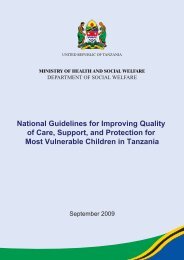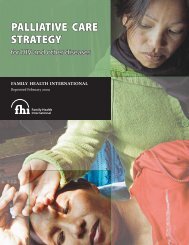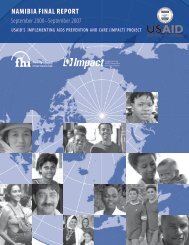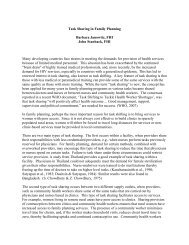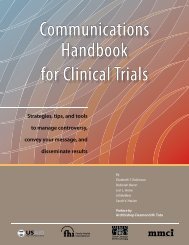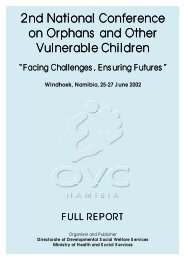Voluntary Counseling and Testing for HIV: A Strategic ... - FHI 360
Voluntary Counseling and Testing for HIV: A Strategic ... - FHI 360
Voluntary Counseling and Testing for HIV: A Strategic ... - FHI 360
Create successful ePaper yourself
Turn your PDF publications into a flip-book with our unique Google optimized e-Paper software.
INTRODUCTION<br />
The <strong>HIV</strong> epidemic continues to spread at an alarming rate,<br />
with over 14,000 new infections per day. While the epidemic<br />
is now spreading rapidly in some parts of Asia <strong>and</strong> Latin<br />
America <strong>and</strong> Caribbean, sub-Saharan Africa continues to<br />
bear the greatest burden of disease. <strong>HIV</strong> prevalence exceeds<br />
30 percent among sexually active adults in some African<br />
cities, <strong>and</strong> AIDS is the leading cause of death in major cities<br />
within sub-Saharan Africa.<br />
More than 90 percent of the estimated 42 million persons<br />
living with <strong>HIV</strong>/AIDS (PLHA) around the world live in resourceconstrained<br />
countries in Africa, Asia, Latin America <strong>and</strong><br />
Caribbean. But despite the very high number of people<br />
already living with <strong>HIV</strong>/AIDS, it is estimated that less than 10<br />
percent are aware they are infected, mainly because of the<br />
limited availability, access, <strong>and</strong> use of voluntary counseling<br />
<strong>and</strong> testing (VCT) <strong>for</strong> <strong>HIV</strong>. This fact greatly hinders ef<strong>for</strong>ts to<br />
respond to the AIDS epidemic, as people have to know if<br />
they are infected if they are to access services. Figure 1 shows<br />
Figure 1<br />
Source: UNAIDS, “Report on the Global<br />
<strong>HIV</strong>/AIDS Epidemic-July 2002” www.unaids.org/<br />
Barcelona, accessed July 8, 2002).<br />
�������� ��������<br />
��� ������ ������<br />
���� ��� ����<br />
�����������<br />
����������<br />
�������� ���<br />
������� ������<br />
����������� ��������<br />
�� ������ ��� ����<br />
�������<br />
����� ���������� ��<br />
���������� ��� ������<br />
���������<br />
����������<br />
��� �������<br />
������� ���������� �������<br />
��� ������������� ������<br />
the benefits of VCT as an entry point to prevention <strong>and</strong> care<br />
services.<br />
<strong>HIV</strong> VCT has long been a component of <strong>HIV</strong> prevention <strong>and</strong><br />
care ef<strong>for</strong>ts among affected communities in developed<br />
countries, <strong>and</strong> is now increasingly being implemented<br />
in resource-constrained countries. In the presence of a<br />
high prevalence <strong>and</strong> growing awareness of <strong>HIV</strong>, several<br />
governments have included VCT services as a major<br />
component of their national <strong>HIV</strong> prevention <strong>and</strong> care<br />
programs.<br />
Because of the recognized importance of <strong>HIV</strong> VCT in<br />
national AIDS control programs, <strong>HIV</strong> VCT services are<br />
in various stages of development in many resourceconstrained<br />
countries. Where available (these services tend<br />
to be of limited quality <strong>and</strong> coverage) they are implemented<br />
by nongovernmental organizations (NGOs) <strong>and</strong> some public<br />
<strong>and</strong> private health centers, clinics, <strong>and</strong> hospitals.<br />
����������� ��������<br />
������<br />
�������<br />
���������������<br />
������������<br />
�������� �����<br />
���������� ��<br />
������������� ����������<br />
��� ����� ��� �����������<br />
��� ���<br />
VCT Toolkit 1


